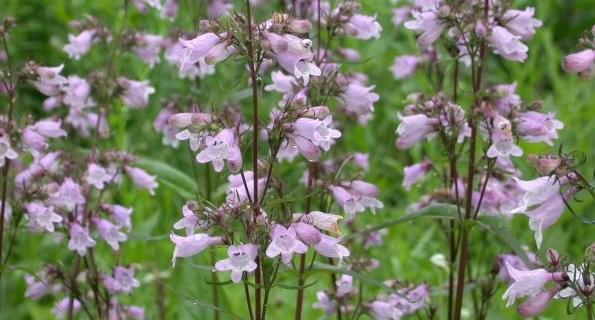
Penstemon calycosus - calico penstemon
FIRST IMPRESSIONS: Penstemon calycosus is a graceful perennial wildflower that expands to form upright clumps. This beardtongue bears deep green toothed leaves on strong upright stems. In summer, plants are topped by showy panicles of tubular snapdragon-like lavender flowers. Pollinators flock to the blooms in sunny or partly shaded sites with well drained loamy soil.
HABITAT & HARDINESS: Penstemon calycosus occurs in the eastern United States from Maine to Georgia and west to Minnesota and Missouri in a variety of habitats.
Through most of its range, the National Wetland Plant List (NWPL) categorizes this species as FACU or Facultative Upland meaning it usually occurs in non-wetlands but sometimes occurs in wetlands.
This species is indigenous to Blackland prairies, oak savannas, open rocky woods, woodland edges and clearings, wet mesic woods, stream banks, moist meadows, alkaline rocky slopes, limestone outcrops, pastures and roadsides. Plants occur in high quality and moderately disturbed habitats.
Plants are hardy from USDA Zones 5-8.
PLANT DESCRIPTION: Penstemon calycosus is an upright perennial with a taproot and smooth green stems.
Leaves are bright green and arranged opposite from each other along the stems. Blades are lanceolate and glossy with serrate edges and pointed tips. The leaves are up to 5” long and 2” across.
Leaves are largest toward the base of the plant – gradually becoming smaller as the stem rises.
The stems terminate in showy branched flower panicles. The florets are tubular, lobed and about 1” long. The outer surface of the corolla tube is pinkish, lavender or purple and the inner surface is white. Each floret has unique long narrow sepals.
Blooming occurs in late spring or early summer for about a month. Florets are followed by small capsules containing many tiny seed.
Plants grow 2-3’ tall with 1-2’ spread.
CULTURAL & MAINTENANCE NEEDS: Penstemon calycosus flourishes in partly sunny sites with moist fertile soil. Plants tolerate clay, alkaline pH and heat.
This species is drought tolerant but less so than many other eastern Penstemon spp. Plants thrive in full sun only if ample moisture is present.
Deadheading to remove dried stalks in fall will allow the semi-evergreen rosettes to function as a winter groundcover in mild climates.
Plants are pest resistant and unpalatable to deer and other herbivores.
LANDSCAPE USES: This is a good choice for a Wildlife Garden, Cut Flower Garden, or Meadow. Plants are also used as Butterfly Nectar Plants or as part of a Groundcover, Grouping or Mass Planting. Penstemon calycosus has Showy Blooms and is appropriate for Cottage Gardens, Deer Resistant Plantings, Water-wise Landscapes, Low Maintenance Plantings, Rain Gardens, Shade Gardens and Perennial Borders.
COMPANION & UNDERSTUDY PLANTS: Try pairing Penstemon calycosus with Aster cordifolius, Carex pensylvanica, Chasmanthium latifolium, Heuchera americana, Rudbeckia laciniata and Zizia aurea.
Penstemon digitalis has similar appearance and culture and could be substituted in some situations.
TRIVIA: Long tongued bees, butterflies, sphinx moths and hummingbirds sip nectar from the flowers. Caterpillars of several moth species feed on the foliage.
Penstemon calycosus resembles P. digitalis. The two grow in similar habitats but P. calycosus has smaller stature, pink to purple flowers, longer sepals, greater shade tolerance and less drought tolerance. P. digitalis is taller with white flowers and is more likely to be found in dry sunny plant communities.
Available in a DP50 (50 liners, 2x2x4.5" deep) from New Moon Nursery for $49.50 which is just $0.99 per plant.


